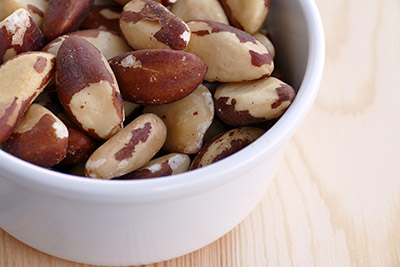 The Brazil nut is part of the Lecythidaceae botanical family. It is native to South America and grown on one of the tallest trees found in the Amazon forest.
The Brazil nut is part of the Lecythidaceae botanical family. It is native to South America and grown on one of the tallest trees found in the Amazon forest.
Brazil nuts grow in a large shell that slightly resembles a coconut. They fall from the tall tree, at which point nut gatherers search the forest floors for these large shells which weigh anywhere from four to six pounds. Once found, they open the shell with a machete, and take out the 18-20 nuts found inside. They then bring them to a processing plant prior to distribution.
Nutrition Information
- Brazil nut is a good source of thiamin and manganese and an excellent source of magnesium, phosphorus, cooper and selenium.
- Thiamin supports the nervous system and conversion of food into energy.
- Manganese metabolizes carbohydrates, proteins and cholesterol and supports wound healing.
- Magnesium is important in blood pressure and blood sugar regulation.
- Phosphorus benefits bone formation and energy production.
- Copper is an antioxidant that aids in bone formation, energy production, and iron metabolism.
- Selenium is an antioxidant that promotes reproduction, and immune and thyroid function.
Nutrition Facts
Brazil nuts, 1 oz.
- Calories: 180
- Protein: 4 g
- Fat: 19 g
- Carbohydrate: 3 g
- Fiber: 1.99 g
- Calcium: 40 mg
- Iron: 0.7 mg
- Vitamin A: 0 µg
Via fdc.nal.usda.gov
Recipes
Request an Appointment